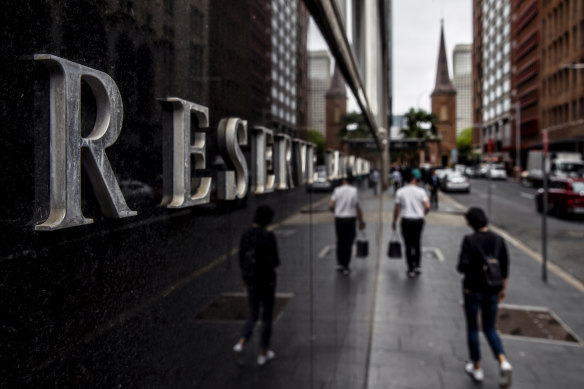This was published 1 year ago
Reserve Bank gives itself scope to lift interest rates further
By Shane Wright
The Reserve Bank is prepared to inflict more pain on the nation’s home buyers with further interest rate rises as population growth, the war between Hamas and Israel, pressure in the rental market and even an El Nino weather event threaten to keep inflation higher for longer.
While revealing Australians’ take-home incomes were being hit by slow wages growth, high prices and increasingly from taxes, the Reserve Bank on Friday said it believed inflation would remain well above its 2-3 per cent target band until at least late 2025.

The Reserve Bank on Friday revised up its inflation forecasts.Credit: Louie Douvis
Some economists believe the bank, which lifted official interest rates this week to a 12-year high of 4.35 per cent, could use its February meeting to further tighten monetary policy. This week’s rate rise will add $100 a month to the repayments on a standard $600,000 mortgage if passed on in full.
In its quarterly outlook for the economy released on Friday, the RBA revised up its consumer price index forecasts, predicting that inflation, which is now at 5.4 per cent, will be at 4.5 per cent by year’s end and at 3.5 per cent by the end of 2024.
At the same time, it revised down its expectations for wages growth. After saying in August it believed wages growth would outpace inflation by the end of 2023, it now does not expect that to occur until June next year.
According to the bank, a range of factors over recent months has meant inflation is not slowing as quickly as it wanted.
“The weight of recent information suggests that the risk of inflation remaining higher for longer has increased,” it said.
All of its forecasts are predicated on a further increase in the official cash rate.
Among the risks to inflation remaining higher, the bank cited a further rise in rent inflation, which is already at its highest level since 2008, as well as the large lift in population growth, which is at its fastest rate since the 1970s.
“Strong population growth is occurring at a time when the rental market is already very tight and it will take time for supply to respond,” it said.
The war between Hamas and Israel, which has roiled international oil markets, was a growing risk that could add to inflationary pressures. Another concern, mentioned on six separate occasions by the RBA in its forecast report, was the prospect of an El Nino, which in Australia is usually associated with drought conditions.
“The El Nino weather pattern and/or ongoing climate change effects could cause disruptions to
agricultural production that increase food prices by more than expected,” it said.
While the bank has regularly raised concerns about a lift in wages adding to Australia’s inflation woes, the Reserve noted there were signs that pay increases were starting to stabilise, with businesses reporting it was slightly easier to find staff. They were not using sign-on bonuses or other extras as frequently to entice prospective new employees.
A growing problem, the bank noted, was the way that inflation, higher interest rates and the tax system were eating into the spending power of many Australians.
“Real household disposable income has been declining since mid-2022 and was 3 per cent lower than a year ago in the June quarter. High inflation, strong growth in tax payments and higher net interest payments have more than offset robust growth in labour incomes,” it said.
AMP senior economist Diana Mousina expects inflation and softer economic growth than that forecast by the Reserve Bank.She said even though inflation was trending down in other parts of the world, the bank might take interest rates higher in coming months.
“In the short term, any major upside data surprises around wages, inflation, the labour market or consumer spending could see the RBA increase interest rates again on concern that it would lead to higher inflation,” she said.
NAB’s head of market economics, Tapas Strickland, said the Reserve had noted that not all of its rate rises had yet to be passed through to borrowers, with many commercial banks negotiating with their customers for better deals.
He said that given the RBA’s own forecasts incorporated another interest rate rise, it seemed likely the bank would move again, probably at its first meeting in 2024.
“In NAB’s view, the RBA’s own forecasts justify another quarter percentage point hike given resilient activity and labour markets and only very gradual progress on inflation. We continue to see the RBA hiking rates by 25 basis points in February,” he said.
Cut through the noise of federal politics with news, views and expert analysis. Subscribers can sign up to our weekly Inside Politics newsletter.